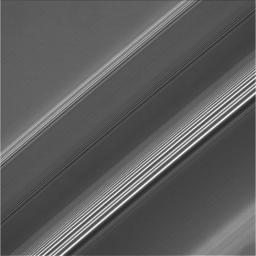
|
Saturn’s Watch Spiral
- Click the image above for a larger view
- Full-Res JPEG (1024 x 1024) (144.7 kB)
- Full-Res TIFF (1024 x 1024) (1.1 MB)
Caption:
Spiral density waves in Saturn's A ring reveal the gravitational signatures of distant moons as they subtly tug on the countless particles orbiting in the ring plane.
Resulting from a process called orbital resonance, a spiral density wave is a spiral-shaped massing of particles that tightly winds many times around the planet. Thus, the wave patterns seen here represent successive windings of each wave, like a close-up view of a watch spring.
Ring scientists can read these patterns, learning from them how quickly the rings are spreading and the amount of mass contained in a region.
This view looks toward the sunlit side of the rings from about 42 degrees below the ringplane. The image was taken in visible light with the Cassini spacecraft narrow-angle camera on April 1, 2008. The view was obtained at a distance of approximately 268,000 kilometers (167,000 miles) from Saturn. Image scale is 1 kilometer (0.6 miles) per pixel.
Background Info:
The Cassini-Huygens mission is a cooperative project of NASA, the European Space Agency and the Italian Space Agency. The Jet Propulsion Laboratory, a division of the California Institute of Technology in Pasadena, manages the mission for NASA's Science Mission Directorate, Washington, D.C. The Cassini orbiter and its two onboard cameras were designed, developed and assembled at JPL. The imaging operations center is based at the Space Science Institute in Boulder, Colo.
For more information about the Cassini-Huygens mission visit http://saturn.jpl.nasa.gov/ . The Cassini imaging team homepage is at http://ciclops.org .
Cataloging Keywords:
| Name | Value | Additional Values |
|---|---|---|
| Target | Saturn Rings | A Ring, Saturn |
| System | Saturn | |
| Target Type | Ring | Planet, Satellite |
| Mission | Cassini-Huygens | |
| Instrument Host | Cassini Orbiter | |
| Host Type | Orbiter | |
| Instrument | Imaging Science Subsystem (ISS) | |
| Detector | Narrow Angle Camera | |
| Extra Keywords | Grayscale, Visual, Wave | |
| Acquisition Date | ||
| Release Date | 2008-05-05 | |
| Date in Caption | 2008-04-01 | |
| Image Credit | NASA/JPL/Space Science Institute | |
| Source | photojournal.jpl.nasa.gov/catalog/PIA09894 | |
| Identifier | PIA09894 | |
